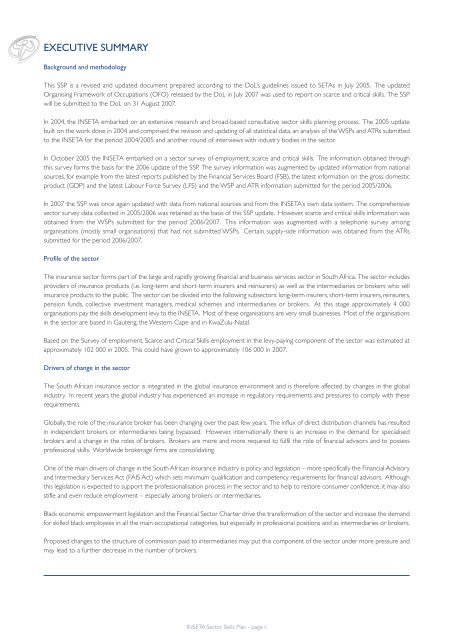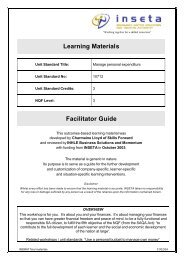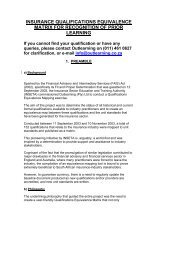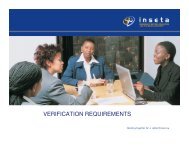SSP Brochure:Layout 1 - INSETA
SSP Brochure:Layout 1 - INSETA
SSP Brochure:Layout 1 - INSETA
You also want an ePaper? Increase the reach of your titles
YUMPU automatically turns print PDFs into web optimized ePapers that Google loves.
EXECUTIVE SUMMARYBackground and methodologyThis <strong>SSP</strong> is a revised and updated document prepared according to the DoL’s guidelines issued to SETAs in July 2005. The updatedOrganising Framework of Occupations (OFO) released by the DoL in July 2007 was used to report on scarce and critical skills. The <strong>SSP</strong>will be submitted to the DoL on 31 August 2007.In 2004, the <strong>INSETA</strong> embarked on an extensive research and broad-based consultative sector skills planning process. The 2005 updatebuilt on the work done in 2004 and comprised the revision and updating of all statistical data, an analysis of the WSPs and ATRs submittedto the <strong>INSETA</strong> for the period 2004/2005 and another round of interviews with industry bodies in the sector.In October 2005 the <strong>INSETA</strong> embarked on a sector survey of employment, scarce and critical skills. The information obtained throughthis survey forms the basis for the 2006 update of the <strong>SSP</strong>. The survey information was augmented by updated information from nationalsources, for example from the latest reports published by the Financial Services Board (FSB), the latest information on the gross domesticproduct (GDP) and the latest Labour Force Survey (LFS) and the WSP and ATR information submitted for the period 2005/2006.In 2007 the <strong>SSP</strong> was once again updated with data from national sources and from the <strong>INSETA</strong>’s own data system. The comprehensivesector survey data collected in 2005/2006 was retained as the basis of this <strong>SSP</strong> update. However, scarce and critical skills information wasobtained from the WSPs submitted for the period 2006/2007. This information was augmented with a telephone survey amongorganisations (mostly small organisations) that had not submitted WSPs. Certain supply-side information was obtained from the ATRssubmitted for the period 2006/2007.Profile of the sectorThe insurance sector forms part of the large and rapidly growing financial and business services sector in South Africa. The sector includesproviders of insurance products (i.e. long-term and short-term insurers and reinsurers) as well as the intermediaries or brokers who sellinsurance products to the public. The sector can be divided into the following subsectors: long-term insurers, short-term insurers, reinsurers,pension funds, collective investment managers, medical schemes and intermediaries or brokers. At this stage approximately 4 000organisations pay the skills development levy to the <strong>INSETA</strong>. Most of these organisations are very small businesses. Most of the organisationsin the sector are based in Gauteng, the Western Cape and in KwaZulu-Natal.Based on the Survey of employment, Scarce and Critical Skills employment in the levy-paying component of the sector was estimated atapproximately 102 000 in 2005. This could have grown to approximately 106 000 in 2007.Drivers of change in the sectorThe South African insurance sector is integrated in the global insurance environment and is therefore affected by changes in the globalindustry. In recent years the global industry has experienced an increase in regulatory requirements and pressures to comply with theserequirements.Globally, the role of the insurance broker has been changing over the past few years. The influx of direct distribution channels has resultedin independent brokers or intermediaries being bypassed. However, internationally there is an increase in the demand for specialisedbrokers and a change in the roles of brokers. Brokers are more and more required to fulfil the role of financial advisors and to possessprofessional skills. Worldwide brokerage firms are consolidating.One of the main drivers of change in the South African insurance industry is policy and legislation – more specifically the Financial Advisoryand Intermediary Services Act (FAIS Act) which sets minimum qualification and competency requirements for financial advisors. Althoughthis legislation is expected to support the professionalisation process in the sector and to help to restore consumer confidence, it may alsostifle and even reduce employment – especially among brokers or intermediaries.Black economic empowerment legislation and the Financial Sector Charter drive the transformation of the sector and increase the demandfor skilled black employees in all the main occupational categories, but especially in professional positions and as intermediaries or brokers.Proposed changes to the structure of commission paid to intermediaries may put this component of the sector under more pressure andmay lead to a further decrease in the number of brokers.<strong>INSETA</strong> Sector Skills Plan - page ii
















